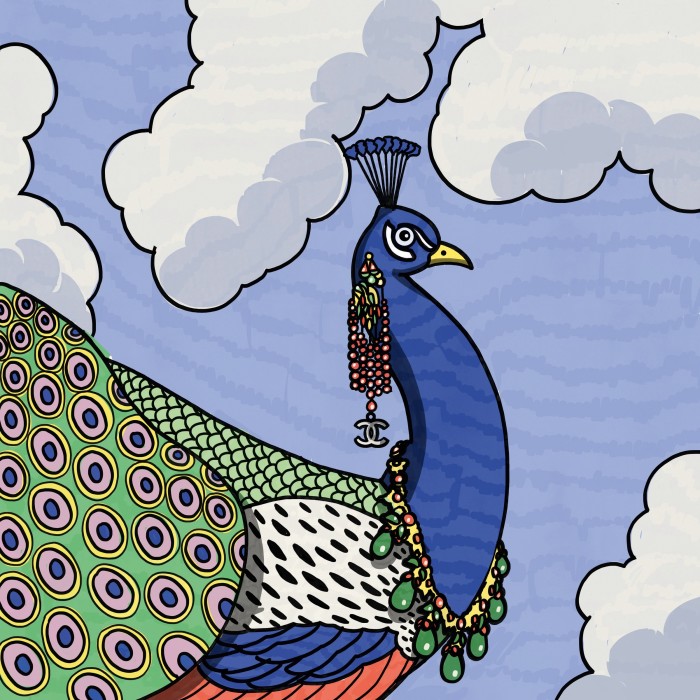How I Spend It… Hannah Rothschild on costume jewellery

Roula Khalaf, Editor of the FT, selects her favourite stories in this weekly newsletter.
My mother, a doyenne of minimalist, elegant style, disliked “paste” jewellery, which she considered “fake” and “vulgar” – two of her most scathing put-downs. Her taste ran to a single row of perfect pearls or a flawless diamond. I, however, take after my father’s side of the family – I am a maximalist and favour what’s known as “Le Goût Rothschild”, a hybrid of the taste of Habsburg princelings’ love of Wunderkammern and the swirly pastel colours of the French rococo. Nowhere is this delicious OTT-ness more apparent than in my forebears’ taste in jewellery. Rothschilds in the 19th century collected necklaces strung with emeralds the size of small biscuits and ornate Renaissance concoctions – sea monsters with pearl bodies encrusted with precious stones, or a sapphire-eyed mermaid with fronds of hair made from tiny pearls and diamonds. These ridiculously valuable, almost unwearable, pieces are now on public display at the British Museum or Waddesdon Manor.
In comparison, I can’t even afford to run to a hippocamp’s eyeball, so imagine my delight, 25 years ago, when in a flea market in Paris I spotted a Rothschildiana-style necklace whose price tag was within my budget. Made from brightly coloured interlocking glass leaves, it was bound together by a lattice of golden thread and studded with sparkly translucent beads. I wore it that night, transforming a boring black dress. I liked it so much that, were it not so clunky, I’d have worn it to bed. So began a long obsession with the results of Maison Gripoix’s collaboration with the house of Chanel.
“Pâte de verre”, or kiln casting, was invented by the Romans but perfected by a young Parisian glassmaker called Augustine Gripoix in the 1860s. The ancient process involved baking coloured glass in a furnace; she let her designs cool naturally in their ceramic moulds. This was easier to work with and gave the glass purity of colour and transparency. Augustine’s first well-known client was the actress Sarah Bernhardt and news of this fabulous costume jewellery spread quickly from the stage to the salons. Society ladies flocked to Maison Augustine to have their originals copied or to purchase adornments for their hats or furs.
One of the maison’s first collaborations was with the designer Paul Poiret in 1910, for clients to wear to performances by Diaghilev’s Ballets Russes, which had recently debuted in Paris. It was a huge success, but it took the legendary Coco Chanel to see the company’s full potential after Augustine passed the business and trade secrets to her daughter Suzanne, who would transform the company’s fortunes. Already known for mixing real and fake pearls, Coco gave Suzanne original pieces of Byzantine jewellery to copy. “Let everyone think that this jewellery is not new, but found somewhere on an excavation site near Rue Cambon,” she is purported to have said. Over the next decades, and even after Coco’s death, the houses of Chanel and Gripoix created extraordinary necklaces, bracelets, brooches, Maltese crosses, fantastical beasts and earrings encrusted with pearls, enamel and diamanté fashioned from glass.
In the early years, I combed bric-à-brac shops and flea markets. The pieces weren’t expensive then, but they were hard to find. In the first decade I only spotted and bought five. Then, as now, there was nothing systematic about my interest. Real collectors are a particular breed of obsessive-compulsives who like to make connections between objects and are driven by the need to make a perfect construct according to their vision; I simply buy what I like.
This haphazard approach was fine until eBay took off, followed by 1stdibs and other online sites. Suddenly, 24 hours a day, I faced worldwide opportunities to acquire Chanel/Gripoix. It was famine to feast and, like a glutton, I made some expensive mistakes. Photographs are often deceptive: an apparently beautiful necklace of burnished gold and glowing jewels turned out to be a brassy, poorly cast fake. One thing, paid for, never appeared and its vendor and website vanished – funny that. I muddle inches and centimetres: what I thought was a delicate shard of encrusted crystal turned out to be the size of a dagger. One pair of earrings would have suited an elephant; another was surely made for a mouse.
I have, finally, learnt some restraint and mainly buy through a few trusted dealers or swap pieces with others: a lady in Paris; a man of indeterminate age in Morocco; and odd shops in France and New York. It’s an odd cabal of associates bound together by mutual interest.
Recently, I decided to insure my collection, now about 60 pieces, and asked a London auction house to value it. When its recommendation arrived, I was horrified and had to re-read the piece of paper several times. Surely they had missed off a nought? The total estimate was far less than I’d paid for a few of the less expensive pieces. I felt intense disappointment followed by irritation: one of us was an ignoramus and I had an awful suspicion it might be me. Then I laughed at myself; it really didn’t matter. Collecting Chanel/Gripoix has never been about financial gain. Nor is it important enough to end up in the British Museum or at Waddesdon Manor. My own children’s taste is closer to my mother’s. For me, it’s a hobby, an interest, the thrill of the chase and, above all, a love of sparkly, impractical things.
Comments